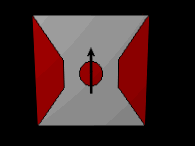
Materials Research Science and Engineering Center: Faculty Publications
Document Type
Article
Date of this Version
2-24-2016
Citation
PHYSICAL REVIEW B 93, 064428 (2016). DOI: 10.1103/PhysRevB.93.064428
Abstract
Recently there has been substantial interest in realizations of skyrmions, in particular in quasi-two-dimensional (2D) systems due to increased stability resulting from reduced dimensionality. A stable skyrmion, representing the smallest realizable magnetic texture, could be an ideal element for ultradense magnetic memories. Here we use the most general form of the quasi-2D free energy with Dzyaloshinskii-Moriya interactions constructed from general symmetry considerations reflecting the underlying system. We predict that the skyrmion phase is robust and it is present even when the system lacks the in-plane rotational symmetry. In fact, the lowered symmetry leads to increased stability of vortex-antivortex lattices with fourfold symmetry and in-plane spirals, in some instances even in the absence of an external magnetic field. Our results relate different hexagonal and square cell phases to the symmetries of materials used for realizations of skyrmions. This will give clear directions for experimental realizations of hexagonal and square cell phases, and will allow engineering of skyrmions with unusual properties. We also predict striking differences in gyrodynamics induced by spin currents for isolated skyrmions and for crystals where spin currents can be induced by charge carriers or by thermal magnons. We find that under certain conditions, isolated skyrmions can move along the current without a side motion which can have implications for realizations of magnetic memories.


Comments
Copyright (c) 2016 American Physical Society. Used by permission.